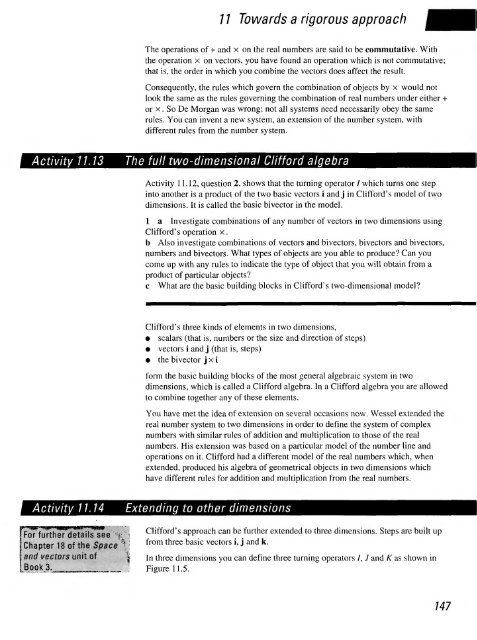history of mathematics - National STEM Centre
history of mathematics - National STEM Centre
history of mathematics - National STEM Centre
You also want an ePaper? Increase the reach of your titles
YUMPU automatically turns print PDFs into web optimized ePapers that Google loves.
7 7 Towards a rigorous approach<br />
The operations <strong>of</strong> + and x on the real numbers are said to be commutative. With<br />
the operation x on vectors, you have found an operation which is not commutative;<br />
that is, the order in which you combine the vectors does affect the result.<br />
Consequently, the rules which govern the combination <strong>of</strong> objects by x would not<br />
look the same as the rules governing the combination <strong>of</strong> real numbers under either +<br />
or x. So De Morgan was wrong; not all systems need necessarily obey the same<br />
rules. You can invent a new system, an extension <strong>of</strong> the number system, with<br />
different rules from the number system.<br />
Activity 11.13 The full two-dimensional Clifford algebra<br />
Activity 11.12, question 2, shows that the turning operator / which turns one step<br />
into another is a product <strong>of</strong> the two basic vectors i and j in Clifford's model <strong>of</strong> two<br />
dimensions. It is called the basic bivector in the model.<br />
1 a Investigate combinations <strong>of</strong> any number <strong>of</strong> vectors in two dimensions using<br />
Clifford's operation x.<br />
b Also investigate combinations <strong>of</strong> vectors and bivectors, bivectors and bivectors,<br />
numbers and bivectors. What types <strong>of</strong> objects are you able to produce? Can you<br />
come up with any rules to indicate the type <strong>of</strong> object that you will obtain from a<br />
product <strong>of</strong> particular objects?<br />
c What are the basic building blocks in Clifford's two-dimensional model?<br />
Clifford's three kinds <strong>of</strong> elements in two dimensions,<br />
• scalars (that is, numbers or the size and direction <strong>of</strong> steps)<br />
• vectors i and j (that is, steps)<br />
• the bivector j x i<br />
form the basic building blocks <strong>of</strong> the most general algebraic system in two<br />
dimensions, which is called a Clifford algebra. In a Clifford algebra you are allowed<br />
to combine together any <strong>of</strong> these elements.<br />
You have met the idea <strong>of</strong> extension on several occasions now. Wessel extended the<br />
real number system to two dimensions in order to define the system <strong>of</strong> complex<br />
numbers with similar rules <strong>of</strong> addition and multiplication to those <strong>of</strong> the real<br />
numbers. His extension was based on a particular model <strong>of</strong> the number line and<br />
operations on it. Clifford had a different model <strong>of</strong> the real numbers which, when<br />
extended, produced his algebra <strong>of</strong> geometrical objects in two dimensions which<br />
have different rules for addition and multiplication from the real numbers.<br />
Activity 11.14 Extending to other dimensions<br />
For further details see<br />
Chapter 18 <strong>of</strong> the Space<br />
and vectors unit <strong>of</strong><br />
BookS.<br />
Clifford's approach can be further extended to three dimensions. Steps are built up<br />
from three basic vectors i, j and k.<br />
In three dimensions you can define three turning operators /, J and K as shown in<br />
Figure 11.5.<br />
747
















